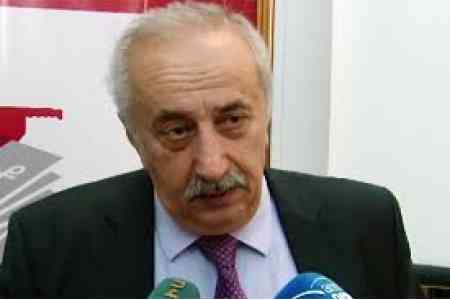


ArmInfo. Despite the 3.7% increase in the gross agricultural output of Armenia in the first quarter of this year (87.3 billion drams), according to official statistics, the growth rate of industry has been low, almost stagnant, in recent years. According to experts, such a deplorable situation in the country's agricultural sector is not accidental and is associated with serious structural economic and demographic shifts over the past 10-15 years.
According to well-known economist, former Minister of Economy of Armenia Armen Yeghiazaryan, over these years there has been a slow but constant reduction (almost 2-fold) in the share of agriculture in GDP due to the growth in the share of the service industry and the transition of country from the category of low- income countries to the category of high average income countries, which it reached in 2018.
In his opinion, the reduction in the share of agriculture in the economy is primarily due to lower productivity and, accordingly, wages in agriculture compared to other sectors, and the subsequent flow of labor resources to more productive areas. Yeghiazaryan believes that the main challenge for agricultural policy has been and remains the problem of the gap in productivity between the national average and the real state of agriculture. At the same time, it is necessary to take into account, first of all, the current demographic situation, as a result of which the increase in employment in non-agricultural sectors is carried out mainly at the expense of the rural population. To stop this process, the economist believes, it is necessary to reduce the difference between the levels of productivity and income in agriculture and the rest of the economy.
"If we extrapolate this current trend into the future, it becomes clear what will happen to our agriculture. It is obvious that the added value in the agricultural sector will decrease, as is happening all over the world, and it will drop to 4-4.5% by 2050. Accordingly, the number of people employed will continue to decrease, and accordingly, the ratio of labor productivity in agriculture to overall labor productivity in the economy will decrease," Yeghiazaryan noted. In his opinion, as far as, figuratively speaking, the village has not become empty, and in order for people to engage in agriculture at all, there is only one way out - to increase the level of productivity in the sector. This can be achieved by starting to implement three important tasks in the country: to begin industrialization of agriculture, through the introduction of modern and "smart" technologies, to begin its commercialization, including through the consolidation of farms, and, lastly, to develop a serious program for the transition to a system of subsidizing farmers' incomes, which is actively used in European countries that are aware that agriculture is an important element of the food security system of any country.
Yeghiazaryan recalled that in independent Armenia there was a fairly strong process of de-industrialization of the economy. Armenia has turned from an industrial country into an agrarian country. And although there has been some industrial recovery in the last 2 decades, however, unlike other countries, industrial production has not become the main driver of economic growth, except for the period when the country was developing mainly due to construction, which ended with the crisis of the construction industry in 2008-2009.
Yeghiazaryan believes that Armenia "missed" the advantage of poverty, which the country has had since 1995. " We have not used this factor sufficiently and, accordingly, economic growth has led to the failure of the concept of cheap labor as the basis of Armenia's industrial development in recent years. That is, if we want to develop the manufacturing industry, then it is too late to rely on cheap labor. Now we need to concentrate on industrial sectors with high added value and conduct an appropriate industrial policy for this. In this vein, if today there are at least some, albeit ineffective, elements of such an incentive policy in agriculture, then in industrial policy they are practically absent. But this is necessary to move from low added value to high added value. And if you look at our manufacturing industry, the core of it is low-value- added industries. And we continue to lose all our advantages. But in high-income countries, the share of industry is significantly higher than in Armenia. The problem is that we, from an agrarian country, bypassing the industrial development phase, immediately found ourselves in a service economy, which became the main driver of development, since in this service sector we still have the advantage of cheap labor.
Notably, according to the RA Statistical Committee, the volume of gross agricultural output in Armenia decreased by 0.3% in 2023 (against 0.4% growth in 2022), to 948.040 billion drams ($2.4 billion). The share of the agricultural sector in the structure of GDP, decreased to 10% in 2023 from 12% in 2022, amid a slowdown in GDP growth from 12.6% in 2022 to 8.7% in 2023.